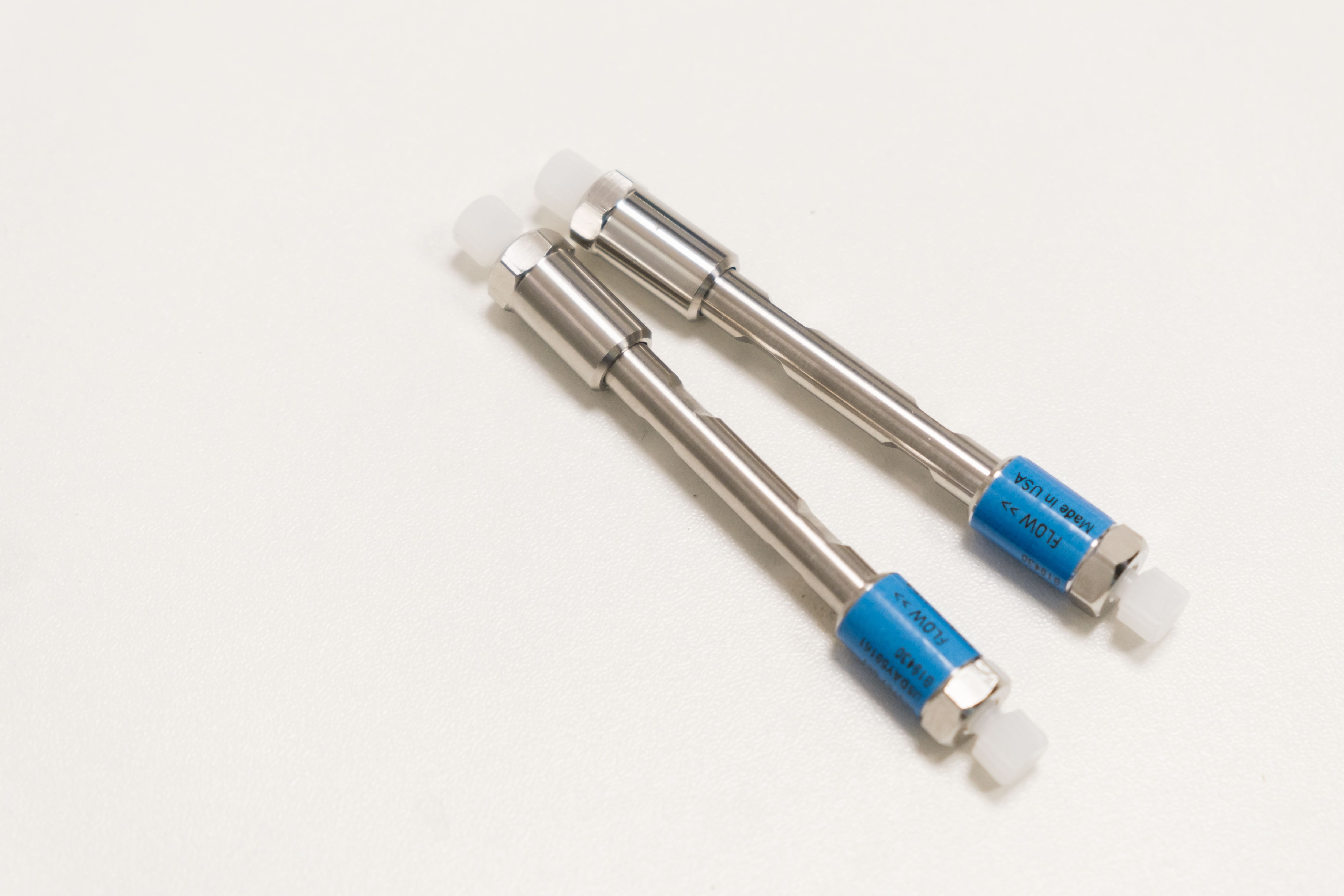Comparing Composites of Four Chiral Metal-Organic Frameworks for Use in High Performance Liquid Chromatography
Mono-type, blending-type, coating-type, and bonding-type chromatographic packings based on chiral metal-organic frameworks (CMOFs) were analyzed regarding their effectiveness in enantioseparation.
A research team based at the Chinese Academy of Sciences has examined new ideas for the improved use and further application of chiral metal-organic frameworks (CMOFs) and their composites as chiral stationary phases (CSPs) in enantioselective high performance liquid chromatography (HPLC) (1).
HPLC 50 mm columns on the table in the laboratory. Fast high performance liquid chromatography analysis in a chemical and microbiological laboratory. Clinical, toxicological and forensic analysis. | Image Credit: © vladim_ka - stock.adobe.com

Enantioseparation refers to the process of separating enantiomers, which are mirror-image isomers of a molecule that have the same chemical composition but differ in their spatial arrangement. In the context of the research, enantioseparation was explored using four types of chiral metal-organic frameworks (CMOFs) as chromatographic packings in HPLC.
The study, published in the Journal of Chromatography A, compared the four types of CMOF-based chromatographic packings: mono-type, in which CMOFs are used directly as CSPs; blending-type, in which the CMOFs are mixed with other materials; and coating-type and bonding-type, which build upon the blending-type assembly.
The concept of metal-organic frameworks (MOFs) came into existence in the mid-1990s, and these structures have numerous advantages including controlled synthesis, high porosity, modular combination, and excellent thermal stability. They are self-assembled from metal clusters with organic ligands, also known as porous coordination polymers (PCPs). Their use over the past three decades has extended to adsorption, catalysis, energy storage, sensing, and separation.
As a branch of MOFs, CMOFs are typically crystalline, porous materials with both a highly ordered and richly adjustable structure that are attracting recent attention for their customizable blend of metal nodes and organic ligands, and their potential in developing new chiral separation systems.
Testing the performance of CMOF-based materials as CSPs could prove specifically useful in pharmacology, where there is a need for accurate chiral separation. While the researchers said about half of the drugs currently taken by humans are enantiomerically pure, those with different configurations could show diametrically opposite pharmacological activities. Chiral liquid chromatography is an accepted method for obtaining enantiomerically pure compounds, and some of the CSPs with exceptional enantioseparation performance include proteins, polysaccharides, and antibiotics.
Although the study touted the overall potential of CMOFs in HPLC, some disadvantages were documented. Namely, mono-type CMOFs may have a wide distribution of dimensions and irregular morphology. In this instance, small particles may block the sieve of the column, resulting in higher column pressure and longer analysis time, while large particles could engender a larger packing gap and column collapse.
Blending-type CMOFs improve column pressure and separation efficiency, but slow mass transfer remains a problem, and irregular chromatographic peaks result from the inhomogeneity of packing dimensions. Coating-type adds silica microspheres with homogeneous particle dimensions as the core, but the bond between the shell layer and core surface is weak, leading to mechanical instability. Finally, the functionalization of silica spheres in bonding-type CMOFs makes their preparation more complicated than the other types.
Yet despite the drawbacks in each of the four CMOFs or composites that the researchers studied, the team concluded that these frameworks’ regular pore structure makes them highly advantageous in the enantioseparation process.
Reference
(1) Liu, C.; Quan, K.; Chen, J.; Shi, X.; Qiu, H. Chiral metal-organic frameworks and their composites as stationary phases for liquid chromatography chiral separation: A minireview. J Chromatogr. A 2023, 1700, 464032. DOI: 10.1016/j.chroma.2023.464032
Study Explores Thin-Film Extraction of Biogenic Amines via HPLC-MS/MS
March 27th 2025Scientists from Tabriz University and the University of Tabriz explored cellulose acetate-UiO-66-COOH as an affordable coating sorbent for thin film extraction of biogenic amines from cheese and alcohol-free beverages using HPLC-MS/MS.
Multi-Step Preparative LC–MS Workflow for Peptide Purification
March 21st 2025This article introduces a multi-step preparative purification workflow for synthetic peptides using liquid chromatography–mass spectrometry (LC–MS). The process involves optimizing separation conditions, scaling-up, fractionating, and confirming purity and recovery, using a single LC–MS system. High purity and recovery rates for synthetic peptides such as parathormone (PTH) are achieved. The method allows efficient purification and accurate confirmation of peptide synthesis and is suitable for handling complex preparative purification tasks.







